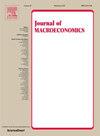Corporate finance and interest rate policy
IF 1.5
3区 经济学
Q3 ECONOMICS
引用次数: 0
Abstract
I develop flexible- and sticky-price general equilibrium models that embody endogenous corporate financing decisions affecting firm value due to distortionary taxes. Nominal interest-rate variations impact the costs of debt and equity capital asymmetrically and thereby induce firms to modify the financial structure, altering the gap between the optimization-based weighted average cost of capital and the real interest rate. Under these circumstances, I characterize conditions under which rules-based monetary policies that set the nominal interest rate as an increasing function of the inflation rate induce aggregate stability in the form of a unique stable equilibrium. In contrast to what is commonly argued, I demonstrate that both passive interest rate policies, which underreact to inflation, and mildly active interest rate policies, which overreact to inflation but below a threshold reflecting both tax and capital structures, ensure determinacy of equilibrium. Conversely, excessively aggressive inflation-fighting monetary actions are destabilizing in the presence of price stickiness by generating either multiple equilibria or the nonexistence of stable equilibria. Under the stabilizing monetary regimes, I prove that macroeconomic dynamics following either interest rate normalization or temporary monetary tightening critically depend upon the tax code and the steady-state debt-equity ratio.
公司财务和利率政策
我开发了灵活价格和粘性价格一般均衡模型,这些模型体现了由于扭曲性税收而影响公司价值的内生企业融资决策。名义利率变化对债务和权益资本成本的影响是不对称的,从而促使企业调整财务结构,改变基于优化的加权平均资本成本与实际利率之间的差距。在这种情况下,我描述了基于规则的货币政策的条件,这些货币政策将名义利率设定为通货膨胀率的递增函数,从而以独特的稳定均衡形式诱导总体稳定。与通常的观点相反,我证明了被动利率政策(对通胀反应不足)和温和积极利率政策(对通胀反应过度,但低于反映税收和资本结构的阈值)都能确保均衡的确定性。相反,在价格粘性存在的情况下,过度激进的抗通胀货币行动会产生多重均衡或不存在稳定均衡,从而破坏稳定。在稳定的货币制度下,我证明了在利率正常化或临时货币紧缩之后的宏观经济动态严重依赖于税法和稳定的债务-权益比率。
本文章由计算机程序翻译,如有差异,请以英文原文为准。
求助全文
约1分钟内获得全文
求助全文
来源期刊

Journal of Macroeconomics
ECONOMICS-
CiteScore
2.50
自引率
7.10%
发文量
53
审稿时长
76 days
期刊介绍:
Since its inception in 1979, the Journal of Macroeconomics has published theoretical and empirical articles that span the entire range of macroeconomics and monetary economics. More specifically, the editors encourage the submission of high quality papers that are concerned with the theoretical or empirical aspects of the following broadly defined topics: economic growth, economic fluctuations, the effects of monetary and fiscal policy, the political aspects of macroeconomics, exchange rate determination and other elements of open economy macroeconomics, the macroeconomics of income inequality, and macroeconomic forecasting.
 求助内容:
求助内容: 应助结果提醒方式:
应助结果提醒方式:


